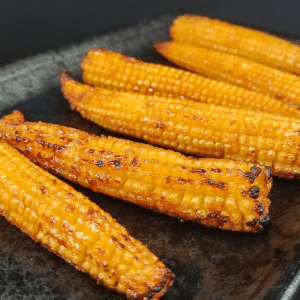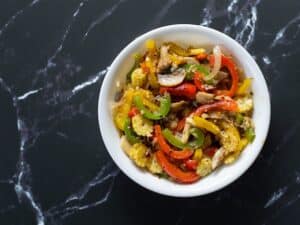No products in the cart.
0 - £0.00
- 0 items
- view cart
No products in the cart.
Baby corn, a miniature version of sweet corn that has been used an Asian cookery for centuries , has gained popularity in the West as a delicious and nutritious addition to various vegetarian culinary delights. With its tender texture and mild flavor, baby corn offers a unique touch to salads, stir-fries, and lots of other dishes.
In this article, we will delve into what baby corn is, discuss its nutritional benefits, explore the cultivation process, highlight its versatile applications in all kinds of dishes and provide some delightful, but easy to prepare, recipes for you to try.
Baby corn is essentially an early-harvested, immature cob of corn, typically harvested within 2-3 days after pollination when the corn is still young and small. It is characterized by its petite size, tender kernels, and a sweet, mild taste.
Unlike regular sweet corn, which is harvested when fully matured and ready to eat, baby corn is appreciated for its delicate texture and versatility in cooking.

Despite its small size, baby corn offers numerous nutritional benefits. It is low in calories and fat while being rich in dietary fiber. Baby corn is also a good source of essential vitamins and minerals such as vitamin C, folate, potassium, and iron. Additionally, it contains antioxidants that help combat free radicals and promote overall health.
There are lots of ways that you can prepare baby corn:
Steaming baby corn is a simple and healthy cooking method that helps retain its natural flavors and nutrients. Place the baby corn in a steamer basket over boiling water and steam for about 5-7 minutes or until tender. Steamed baby corn is great for adding to salads, stir-fries, or enjoying as a standalone side dish.
Stir-frying baby corn in a hot skillet or wok is a popular cooking method that allows you to cook it quickly while retaining its crunch. Heat some oil in the pan, add the baby corn along with other vegetables or proteins, and stir-fry over high heat for a few minutes until cooked but still crisp. Season with your preferred sauces and spices for a flavorful stir-fry.
Boiling baby corn is a straightforward method that requires immersing the corn in boiling water until tender. Bring a pot of water to a boil, add the baby corn, and cook for about 5-7 minutes. Drain and use in salads, soups, or as a side dish.
BBQ baby corn adds a delightful smoky flavor and charred texture to the kernels. Preheat the grill to medium-high heat and brush the baby corn with a little oil or marinade. Place them directly on the grill grates and cook for about 10-12 minutes, turning occasionally, until charred and tender. Grilled baby corn is perfect as a side dish, appetizer, or as an ingredient in salads and skewers.
Roasting baby corn in the oven is a fantastic way to bring out its natural sweetness and create a slightly caramelized exterior. Preheat the oven to 200°C. Toss the baby corn with some olive oil, salt, and pepper, then spread them in a single layer on a baking sheet. Roast for about 15-20 minutes, turning halfway through, until tender and lightly golden. Roasted baby corn can be enjoyed as a side dish or used in various recipes.
Air frying baby corn is a healthier alternative to deep-frying while still achieving a crispy texture. Toss the baby corn with a little oil and your preferred seasonings, then place them in the air fryer basket. Cook at around 200°C for about 10-12 minutes, shaking the basket halfway through to ensure even cooking. Air-fried baby corn makes a delicious snack or appetizer.

Ingredients:
Instructions:
Ingredients:
Instructions:
Ingredients:
Instructions:
Baby corn is the early-harvested, immature form of corn, picked within a few days of pollination. It is smaller in size, with tender kernels and a mild, slightly sweet taste. Unlike regular corn, which is allowed to fully mature on the cob, baby corn is harvested before reaching its full size.
While baby corn can be eaten raw, it is most commonly cooked or prepared in some way before consuming. Cooking methods like steaming, stir-frying, boiling, grilling, or roasting bring out its flavors and enhance its texture. However, if you prefer a crisp, fresh crunch, you can enjoy baby corn raw as part of a salad or as a crunchy addition to sandwiches and wraps.
Yes, baby corn offers several nutritional benefits. It is low in calories and fat, making it a good choice for weight management. Baby corn is also a good source of dietary fiber, vitamins C and A, folate, potassium, and iron. It contains antioxidants that help fight free radicals and promote overall health. Including baby corn in your meals adds a nutritious boost to your diet.
While baby corn can be substituted for regular corn in some recipes, it’s important to consider the differences in texture and cooking time. Baby corn is tender and requires less cooking time compared to mature corn. It works well in stir-fries, salads, and appetizers. However, for recipes that require the sweetness and juiciness of fully matured corn, such as corn on the cob or cornbread, it is best to use regular corn.
To store baby corn, remove any husks or packaging and place it in a perforated plastic bag in the refrigerator. It can stay fresh for up to a week when stored properly. If you want to extend its shelf life, blanch the baby corn briefly in boiling water, then cool and freeze it in airtight containers or freezer bags. Frozen baby corn can be used for up to six months and is convenient for future use in various recipes.
⭐️⭐️⭐️⭐️⭐️ Plant Sumo’s Soul Curry has been the perfect fully plant based substitute for my favorite curry dishes and I look forward to this option with each order :) – Lydia Sims
Plant Sumo is a part of the Pearl Lemon Group . We also run three Cafe’s – Pearl Lemon Café (w/lots of plants), Pearl Lemon Catering, Pearl Lemon Boba, and How Matcha (come visit) in London!
© All Rights Reserved | Company Number: 10411490 | VAT Number: 252 7124 23 | Sitemap